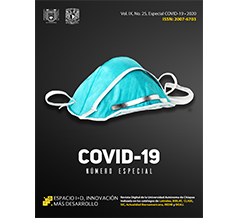Aplicaciones de nanopartículas en textiles para el diseño de interiores
DOI:
https://doi.org/10.31644/IMASD.10.2016.a07Palabras clave:
Nanopartículas de plata, Nanopartículas de óxido de zinc, Nanopartículas de oro, Nanotextiles, Diseño de interioresResumen
Los textiles son un material ampliamente utilizado en el diseño de interiores y en la vida cotidiana. Los avances de la nanotecnología han alcanzado de manera importante a la industria textil, dando lugar a fibras inteligentes con grandes beneficios para el usuario. Esta investigación tiene como propósito revisar el estado del arte acerca de la aplicación de la nanotecnología en los textiles en el campo del interiorismo, así como sus múltiples funciones. Se analizaron las principales propiedades de este tipo de fibras que han permitido otras oportunidades a la industria textil.
Descargas
Citas
Abdel-Mohsen, A. M., Abdel-Rahman, R. M., Hrdina, R., Imramovsky, A., Burgert, L., y Aly, A. S. (2012). Antibacterial cotton fabrics treated with core-shell nanoparticles. Int J Biol Macromol, 50(5), 1245-1253. doi:10.1016/j.ijbiomac.2012.03.018
Addington, M., Schodek, D. (2005). Smart materials and new technologies. Burlington, MA, USA: Elsevier.
Agiotis, L., Theodorakos, I., Samothrakitis, S., Papazoglou, S., Zergioti, I., y Raptis, Y. S. (2016). Magnetic manipulation of superparamagnetic nanoparticles in a microfluidic system for drug delivery applications. Journal of Magnetism and Magnetic Materials, 401, 956-964. doi: http://dx.doi.org/10.1016/j.jmmm.2015.10.111
Ahmed, K. B. A., Senthilnathan, R., Megarajan, S., y Anbazhagan, V. (2015). Sunlight mediated synthesis of silver nanoparticles using redox phytoprotein and their application in catalysis and colorimetric mercury sensing. Journal of Photochemistry and Photobiology B: Biology, 151, 39-45. doi: http://dx.doi.org/10.1016/j.jphotobiol.2015.07.003
Aixtex. (2015). Aitex: RyD an innovation. Retrieved from http://www.aitex.es/en/home-ingles/about-aitex
Albrecht, M. A., Evans, C. W., y Raston, C. L. (2006). Green chemistry and the health implications of nanoparticles. Green Chemistry, 8(5), 417-432. doi:10.1039/B517131H
Allaker, R. P., y Memarzadeh, K. (2014). Nanoparticles and the control of oral infections. International Journal of Antimicrobial Agents, 43(2), 95-104. doi: http://dx.doi.org/10.1016/j.ijantimicag.2013.11.002
Alongi, J., Carosio, F., y Malucelli, G. (2014). Current emerging techniques to impart flame retardancy to fabrics: An overview. Polymer Degradation and Stability, 106, 138-149. doi:10.1016/j.polymdegradstab.2013.07.012
Ashby, M., Ferreira, P., y Schodek, D. (2009). Nanomaterials, nanotechnologies and design. Burlington, MA, USA: Elsevier.
Ashby, M. F., Bréchet, Y. J. M., Cebon, D., y Salvo, L. (2004). Selection strategies for materials and processes. Materials y Design, 25(1), 51-67. doi:10.1016/s0261-3069(03)00159-6
Baelo, A., Levato, R., Julián, E., Crespo, A., Astola, J., Gavaldà, J., . . . Torrents, E. (2015). Disassembling bacterial extracellular matrix with DNase-coated nanoparticles to enhance antibiotic delivery in biofilm infections. Journal of Controlled Release, 209, 150-158. doi: http://dx.doi.org/10.1016/j.jconrel.2015.04.028
Becheri, A., Dürr, M., Lo Nostro, P., Baglioni, P. (2008). Synthesis and characterization of zinc oxide nanoparticles: application to textiles as UV-absorbers. Journal of Nanoparticles Research, 10, 679-689.
Bera, A., Garai, P., Singh, R., Prakash Gupta, P., Malav, S., Singh, D., . . . Vaijapurkar, S. G. (2015). Gamma radiation synthesis of colloidal AgNPs for its potential application in antimicrobial fabrics. Radiation Physics and Chemistry, 115, 62-67. doi: http://dx.doi.org/10.1016/j.radphyschem.2015.05.041
Bozzi, A., Yuranova, T., y Kiwi, J. (2005). Self-cleaning of wool-polyamide and polyester textiles by TiO2-rutile modification under daylight irradiation at ambient temperature. Journal of Photochemistry and Photobiology A: Chemistry, 172(1), 27-34. doi: http://dx.doi.org/10.1016/j.jphotochem.2004.11.010
Chan Vili, Y. Y. F. (2007). Investigating Smart Textiles Based on Shape Memory Materials. Textile Research Journal, 77(5), 290-300. doi:10.1177/0040517507078794
Chen, F., Liu, X., Yang, H., Dong, B., Zhou, Y., Chen, D., . . . Xu, W. (2016). A simple one-step approach to fabrication of highly hydrophobic silk fabrics. Applied Surface Science, 360, Part A, 207-212. doi: http://dx.doi.org/10.1016/j.apsusc.2015.10.186
Chen, X., Yao, X., Wang, C., Chen, L., y Chen, X. (2015). Mesoporous silica nanoparticles capped with fluorescence-conjugated cyclodextrin for pH-activated controlled drug delivery and imaging. Microporous and Mesoporous Materials, 217, 46-53. doi: http://dx.doi.org/10.1016/j.micromeso.2015.06.012
Clouser, S., Samia, A. S., Navok, E., Alred, J., y Burda, C. (2008). Visible-light Photodegradation of Higher Molecular Weight Organics on N-doped TiO2 Nanostructured Thin Films. Topics in Catalysis, 47(1-2), 42-48. doi:10.1007/s11244-007-9037-0<7p>
D’Angelo, I., Casciaro, B., Miro, A., Quaglia, F., Mangoni, M. L., y Ungaro, F. (2015). Overcoming barriers in Pseudomonas aeruginosa lung infections: Engineered nanoparticles for local delivery of a cationic antimicrobial peptide. Colloids and Surfaces B: Biointerfaces, 135, 717-725. doi: http://dx.doi.org/10.1016/j.colsurfb.2015.08.027
Da Silva Pereira, B., Silva, M. F., Bittencourt, P. R. S., de Oliveira, D. M. F., Pineda, E. A. G., y Hechenleitner, A. A. W. (2015). Cellophane and filter paper as cellulosic support for silver nanoparticles and its thermal decomposition catalysis. Carbohydrate Polymers, 133, 277-283. doi: http://dx.doi.org/10.1016/j.carbpol.2015.06.108
Dastjerdi, R., y Montazer, M. (2010). A review on the application of inorganic nano-structured materials in the modification of textiles: Focus on anti-microbial properties. Colloids and Surfaces B: Biointerfaces, 79(1), 5-18. doi: http://dx.doi.org/10.1016/j.colsurfb.2010.03.029
Díaz, L. (2013). Trapitos al arte. Revista Mundo FESC, 5, 52-56.
Dubas, S. T., Kumlangdudsana, P., y Potiyaraj, P. (2006). Layer-by-layer deposition of antimicrobial silver nanoparticles on textile fibers. Colloids and Surfaces A: Physicochemical and Engineering Aspects, 289(1-3), 105-109. doi: http://dx.doi.org/10.1016/j.colsurfa.2006.04.012
Durán, N., Marcato, P. D., De Souza, G. I. H., Alves, O. L., y Esposito, E. (2007). Antibacterial Effect of Silver Nanoparticles Produced by Fungal Process on Textile Fabrics and Their Effluent Treatment. Journal of Biomedical Nanotechnology, 3(2), 203-208. doi:10.1166/jbn.2007.022
El-Drieny, E. A. E. A., Sarhan, N. I., Bayomy, N. A., Elsherbeni, S. A. E., Momtaz, R., y Mohamed, H. E.-D. (2015). Histological and immunohistochemical study of the effect of gold nanoparticles on the brain of adult male albino rat. Journal of Microscopy and Ultrastructure, 3(4), 181-190. doi: http://dx.doi.org/10.1016/j.jmau.2015.05.001
El-Rafie, M. H., Mohamed, A. A., Shaheen, T. I., y Hebeish, A. (2010). Antimicrobial effect of silver nanoparticles produced by fungal process on cotton fabrics. Carbohydrate Polymers, 80(3), 779-782. doi: http://dx.doi.org/10.1016/j.carbpol.2009.12.028
El-Rafie, M. H., Shaheen, T. I., Mohamed, A. A., y Hebeish, A. (2012). Bio-synthesis and applications of silver nanoparticles onto cotton fabrics. Carbohydr Polym, 90(2), 915-920. doi:10.1016/j.carbpol.2012.06.020
Elhalawany, N., Mossad, M. A., y Zahran, M. K. (2014). Novel water based coatings containing some conducting polymers nanoparticles (CPNs) as corrosion inhibitors. Progress in Organic Coatings, 77(3), 725-732. doi: http://dx.doi.org/10.1016/j.porgcoat.2013.12.017
Erdem, N., Cireli, A. A., y Erdogan, U. H. (2009). Flame retardancy behaviors and structural properties of polypropylene/nano-SiO2 composite textile filaments. Journal of Applied Polymer Science, 111(4), 2085-2091. doi:10.1002/app.29052
European_Commission. (2013). Nanotechnologies: principles, applications, implications and hands-on activities. Luxemburgo: Publications Office of the European Union.
Fakin, D., Stana Kleinschek, K., Kurečič, M., y Ojstršek, A. (2014). Effects of nanoTiO2-SiO2 on the hydrophilicity/dyeability of polyester fabric and photostability of disperse dyes under UV irradiation. Surface and Coatings Technology, 253, 185-193. doi:10.1016/j.surfcoat.2014.05.035
Filella, M. (2012). 1.07 - Nanomaterials. In J. Pawliszyn (Ed.), Comprehensive Sampling and Sample Preparation (pp. 109-124). Oxford: Academic Press.
Fitoz, I. (2015). Interior Design Education Programs during Historical Periods. Procedia - Social and Behavioral Sciences, 174, 4122-4129. doi: http://dx.doi.org/10.1016/j.sbspro.2015.01.1248
Gaillet, S., y Rouanet, J. M. (2015). Silver nanoparticles: Their potential toxic effects after oral exposure and underlying mechanisms - A review. Food Chem Toxicol, 77C, 58-63. doi:10.1016/j.fct.2014.12.019
García-Serrano, L. (2010). Influencia de la nanotecnología en el sector textil. (Doctorado), Instituto Politécnico Nacional, México, D.F.
Gasman, L. (2006). Nanotechnology applications and markets. Norwood, MA, USA: Artech House, Inc.
Girigoswami, K., Viswanathan, M., Murugesan, R., y Girigoswami, A. (2015). Studies on polymer-coated zinc oxide nanoparticles: UV-blocking efficacy and in vivo toxicity. Materials Science and Engineering: C, 56, 501-510. doi: http://dx.doi.org/10.1016/j.msec.2015.07.017
Gugliuzza, A., y Drioli, E. (2013). A review on membrane engineering for innovation in wearable fabrics and protective textiles. Journal of Membrane Science, 446, 350-375. doi: http://dx.doi.org/10.1016/j.memsci.2013.07.014
Gulrajani, M. L. (2013). 12 - The use of nanotechnology in the finishing of technical textiles. In M. L. Gulrajani (Ed.), Advances in the Dyeing and Finishing of Technical Textiles (pp. 280-308): Woodhead Publishing.
Hashemikia, S., y Montazer, M. (2012). Sodium hypophosphite and nano TiO2 inorganic catalysts along with citric acid on textile producing multi-functional properties. Applied Catalysis A: General, 417-418, 200-208. doi: http://dx.doi.org/10.1016/j.apcata.2011.12.041
Hayles, C. S. (2015). Environmentally sustainable interior design: A snapshot of current supply of and demand for green, sustainable or Fair Trade products for interior design practice. International Journal of Sustainable Built Environment, 4(1), 100-108. doi:10.1016/j.ijsbe.2015.03.006
Herea, D. D., Chiriac, H., Lupu, N., Grigoras, M., Stoian, G., Stoica, B. A., y Petreus, T. (2015). Study on iron oxide nanoparticles coated with glucose-derived polymers for biomedical applications. Applied Surface Science, 352, 117-125. doi: http://dx.doi.org/10.1016/j.apsusc.2015.03.137
Hu, L., Pfirman, A., y Chumanov, G. (2015). Stabilization of 2D assemblies of silver nanoparticles by spin-coating polymers. Applied Surface Science, 357, Part B, 1587-1592. doi: http://dx.doi.org/10.1016/j.apsusc.2015.10.029
INEGI. (2013). La industria textil y del vestido en México 2013. Retrieved from México, D.F.:
ISO, I. O. f. S. (2008). Technical specification ISO/TS 27687:2008 (E). París Francia: International Organization for Standardization ISO
Jayaraman, P., Gandhimathi, C., Venugopal, J. R., Becker, D. L., Ramakrishna, S., y Srinivasan, D. K. Controlled release of drugs in electrosprayed nanoparticles for bone tissue engineering. Adv Drug Deliv Rev. doi: http://dx.doi.org/10.1016/j.addr.2015.09.007
Jinlian, H. (2011). Adaptive and Functional Polymers, Textiles and Their Applications. London: Imperial College Press.
Jinlian, H., Harper, M., Guoqiang, L., y Samuel, I. I. (2012). A review of stimuli-responsive polymers for smart textile applications. Smart Materials and Structures, 21(5), 053001. Retrieved from http://stacks.iop.org/0964-1726/21/i=5/a=053001
Johnston, J., y Lucas, K. (2011). Nanogold synthesis in wool fibres: novel colourants. Gold Bulletin, 44(2), 85-89. doi:10.1007/s13404-011-0012-y
Katz, L. M., Dewan, K., y Bronaugh, R. L. Nanotechnology in cosmetics. Food and Chemical Toxicology. doi: http://dx.doi.org/10.1016/j.fct.2015.06.020
Komeily-Nia, Z., Montazer, M., y Latifi, M. (2013). Synthesis of nano copper/nylon composite using ascorbic acid and CTAB. Colloids and Surfaces A: Physicochemical and Engineering Aspects, 439, 167-175. doi: http://dx.doi.org/10.1016/j.colsurfa.2013.03.003
Lee, H. J., Yeo, S. Y., y Jeong, S. H. (2003). Antibacterial effect of nanosized silver colloidal solution on textile fabrics. Journal of Materials Science, 38(10), 2199-2204. doi:10.1023/A:1023736416361
Liu, J., Li, Q., y Xu, S. (2015). Influence of nanoparticles on fluidity and mechanical properties of cement mortar. Construction and Building Materials, 101, Part 1, 892-901. doi: http://dx.doi.org/10.1016/j.conbuildmat.2015.10.149
Lo, S.-H., Wu, M.-C., y Wu, S.-P. (2015). A turn-on fluorescent sensor for cysteine based on BODIPY functionalized Au nanoparticles and its application in living cell imaging. Sensors and Actuators B: Chemical, 221, 1366-1371. doi: http://dx.doi.org/10.1016/j.snb.2015.08.015
Lodeiro, P., Achterberg, E. P., Pampín, J., Affatati, A., y El-Shahawi, M. S. (2016). Silver nanoparticles coated with natural polysaccharides as models to study AgNP aggregation kinetics using UV-Visible spectrophotometry upon discharge in complex environments. Science of The Total Environment, 539, 7-16. doi: http://dx.doi.org/10.1016/j.scitotenv.2015.08.115
Lu, P.-J., Huang, S.-C., Chen, Y.-P., Chiueh, L.-C., y Shih, D. Y.-C. (2015). Analysis of titanium dioxide and zinc oxide nanoparticles in cosmetics. Journal of Food and Drug Analysis, 23(3), 587-594. doi: http://dx.doi.org/10.1016/j.jfda.2015.02.009
Luo, Y., Yang, J., Li, J., Yu, Z., Zhang, G., Shi, X., y Shen, M. (2015). Facile synthesis and functionalization of manganese oxide nanoparticles for targeted T1-weighted tumor MR imaging. Colloids and Surfaces B: Biointerfaces, 136, 506-513. doi: http://dx.doi.org/10.1016/j.colsurfb.2015.09.053
McIntyre, R. A. (2012). Common nano-materials and their use in real world applications. Science Progress, 95(1), 1. Retrieved from http://ezproxy.uacj.mx/login?url=http://search.ebscohost.com/login.aspx?direct=trueydb=edbyAN=73822846ylang=esysite=eds-live
Montazer, M., Seifollahzadeh, S. (2011). Enhanced Self-cleaning, Antibacterial and UV Protection Properties ofNano TiO2Treated Textile through Enzymatic Pretreatment. Photochemistry and Photobiology, 87, 877-883.
Mura, S., Greppi, G., Malfatti, L., Lasio, B., Sanna, V., Mura, M. E., . . . Lugliè, A. (2015). Multifunctionalization of wool fabrics through nanoparticles: A chemical route towards smart textiles. J Colloid Interface Sci, 456, 85-92. doi: http://dx.doi.org/10.1016/j.jcis.2015.06.018<7p>
Nateghi, M. R., y Shateri-Khalilabad, M. (2015). Silver nanowire-functionalized cotton fabric. Carbohydrate Polymers, 117, 160-168. doi: http://dx.doi.org/10.1016/j.carbpol.2014.09.057
Nosrati, R., Olad, A., y Nofouzi, K. (2015). A self-cleaning coating based on commercial grade polyacrylic latex modified by TiO2/Ag-exchanged-zeolite-A nanocomposite. Applied Surface Science, 346, 543-553. doi: http://dx.doi.org/10.1016/j.apsusc.2015.04.056
Padmavathy, N., Vijayaraghavan, R. (2008). Enhanced bioactivity of ZnO nanoparticles-an antimicrobial study. Science and technology of advanced materials, 9(035004), 1-7.
Pandurangan, M., y Kim, D. H. (2015). ZnO nanoparticles augment ALT, AST, ALP and LDH expressions in C2C12 cells. Saudi Journal of Biological Sciences, 22(6), 679-684. doi: http://dx.doi.org/10.1016/j.sjbs.2015.03.013
Pasqui, D., y Barbucci, R. (2014). Synthesis, characterization and self cleaning properties of titania nanoparticles grafted on polyester fabrics. Journal of Photochemistry and Photobiology A: Chemistry, 274, 1-6. doi:10.1016/j.jphotochem.2013.08.017
Piccinno, F. G., F., Seeger, S., Nowack, B. (2012). Industrial production quantities and uses of ten engineered nanomaterials in Europe and the world. Journal of Nanoparticles Research, 14, 1109.
Pinho, L., Rojas, M., y Mosquera, M. J. (2015). Ag-SiO2-TiO2 nanocomposite coatings with enhanced photoactivity for self-cleaning application on building materials. Applied Catalysis B: Environmental, 178, 144-154. doi: http://dx.doi.org/10.1016/j.apcatb.2014.10.002
Quispe-Chejo, V. H. (2010). Aplicaciones industriales de la Nanotecnología. Revista de Información, Tecnología y Sociedad(5), 58-61.
Raftery, R. M., Tierney, E. G., Curtin, C. M., Cryan, S.-A., y O'Brien, F. J. (2015). Development of a gene-activated scaffold platform for tissue engineering applications using chitosan-pDNA nanoparticles on collagen-based scaffolds. Journal of Controlled Release, 210, 84-94. doi: http://dx.doi.org/10.1016/j.jconrel.2015.05.005
Sataev, M. S., Koshkarbaeva, S. T., Tleuova, A. B., Perni, S., Aidarova, S. B., y Prokopovich, P. (2014). Novel process for coating textile materials with silver to prepare antimicrobial fabrics. Colloids and Surfaces A: Physicochemical and Engineering Aspects, 442, 146-151. doi: http://dx.doi.org/10.1016/j.colsurfa.2013.02.018
Sawhney, A. P. S., Condon, B., Singh, K. V., Pang, S. S., Li, G., y Hui, D. (2008). Modern Applications of Nanotechnology in Textiles. Textile Research Journal, 78(8), 731-739. doi:10.1177/0040517508091066
Sayes, C. M., y Santamaria, A. B. (2014). Chapter 5 - Toxicological Issues to Consider When Evaluating the Safety of Consumer Products Containing Nanomaterials. In M. S. Hull y D. M. Bowman (Eds.), Nanotechnology Environmental Health and Safety (Second Edition) (pp. 77-115). Oxford: William Andrew Publishing.
Selvam, S., Rajiv Gandhi, R., Suresh, J., Gowri, S., Ravikumar, S., y Sundrarajan, M. (2012). Antibacterial effect of novel synthesized sulfated beta-cyclodextrin crosslinked cotton fabric and its improved antibacterial activities with ZnO, TiO2 and Ag nanoparticles coating. Int J Pharm, 434(1-2), 366-374. doi:10.1016/j.ijpharm.2012.04.069
Shaheen, T. I., El-Naggar, M. E., Abdelgawad, A. M., y Hebeish, A. Durable antibacterial and UV protections of in situ synthesized Zinc oxide nanoparticles onto cotton fabrics. Int J Biol Macromol. doi: http://dx.doi.org/10.1016/j.ijbiomac.2015.11.003
Shen, S.-C., Ng, W. K., Dong, Y.-C., Ng, J., y Tan, R. B. H. (2016). Nanostructured material formulated acrylic bone cements with enhanced drug release. Materials Science and Engineering: C, 58, 233-241. doi:http://dx.doi.org/10.1016/j.msec.2015.08.011
Sierra-Rodero, M., Fernández-Romero, J. M., y Gómez-Hens, A. (2011). Photometric determination of thioglycolic acid in cosmetics by using a stopped-flow reverse flow-injection system and the formation of gold nanoparticles. Microchemical Journal, 97(2), 243-248. doi: http://dx.doi.org/10.1016/j.microc.2010.09.011
Soltanian, H., Khalokakaie, R., Ataei, M., y Kazemzadeh, E. (2015). Fe2O3 nanoparticles improve the physical properties of heavy-weight wellbore cements: A laboratory study. Journal of Natural Gas Science and Engineering, 26, 695-701. doi: http://dx.doi.org/10.1016/j.jngse.2015.06.004
Stone, R. C., Fellows, B. D., Qi, B., Trebatoski, D., Jenkins, B., Raval, Y., . . . Mefford, O. T. (2015). Highly stable multi-anchored magnetic nanoparticles for optical imaging within biofilms. J Colloid Interface Sci, 459, 175-182. doi: http://dx.doi.org/10.1016/j.jcis.2015.08.012
Sun, L.-H., Yang, Z.-G., y Li, X.-H. (2008a). Tensile and tribological properties of PTFE and nanoparticles modified epoxy-based polyester fabric composites. Materials Science and Engineering: A, 497(1-2), 487-494. doi: http://dx.doi.org/10.1016/j.msea.2008.07.049
Sun, L.-H., Yang, Z.-G., y Li, X.-H. (2008b). Tensile and tribological properties of PTFE and nanoparticles modified epoxy-based polyester fabric composites. Materials Science and Engineering: A, 497(1-2), 487-494. doi:10.1016/j.msea.2008.07.049
Tolfree, D., Jackson, M. (2008). Commercializing micro-nanotechnology products. Boca Ratón, FL: CRC Press.
Van Langenhove, L., Hertleer, C. (2004). Smart clothing: a new life. International Journal of Clothing Science and Technology, 16(12), 63-72.
Van Langenhove, L., Hertleer, C. Catrysse, M., Puers, R., Van Egmond, H., Matthijs, D. (2004). Smart textiles. Amsterdam: IOS Press.
Virovska, D., Paneva, D., Manolova, N., Rashkov, I., y Karashanova, D. (2016). Photocatalytic self-cleaning poly(l-lactide) materials based on a hybrid between nanosized zinc oxide and expanded graphite or fullerene. Materials Science and Engineering: C, 60, 184-194. doi: http://dx.doi.org/10.1016/j.msec.2015.11.029
Wasmuth, C., Rüdel, H., Düring, R.-A., y Klawonn, T. (2016). Assessing the suitability of the OECD 29 guidance document to investigate the transformation and dissolution of silver nanoparticles in aqueous media. Chemosphere, 144, 2018-2023. doi: http://dx.doi.org/10.1016/j.chemosphere.2015.10.101
Wijesena, R. N., Tissera, N. D., Perera, R., Nalin de Silva, K. M., y Amaratunga, G. A. J. (2015). Slightly carbomethylated cotton supported TiO2 nanoparticles as self-cleaning fabrics. Journal of Molecular Catalysis A: Chemical, 398, 107-114. doi:10.1016/j.molcata.2014.11.012
Xu, B., Cai, Z., Wang, W., y Ge, F. (2010). Preparation of superhydrophobic cotton fabrics based on SiO2 nanoparticles and ZnO nanorod arrays with subsequent hydrophobic modification. Surface and Coatings Technology, 204(9-10), 1556-1561. doi:10.1016/j.surfcoat.2009.09.086
Ye, J.-S., Liu, Z.-T., Lai, C.-C., Lo, C.-T., y Lee, C.-L. (2016). Diameter effect of electrospun carbon fiber support for the catalysis of Pt nanoparticles in glucose oxidation. Chemical Engineering Journal, 283, 304-312. doi:http://dx.doi.org/10.1016/j.cej.2015.07.071
Zanetta, M., Quirici, N., Demarosi, F., Tanzi, M. C., Rimondini, L., y Fare, S. (2009). Ability of polyurethane foams to support cell proliferation and the differentiation of MSCs into osteoblasts. Acta Biomater, 5(4), 1126-1136. doi:10.1016/j.actbio.2008.12.003
Zhang, F., Kong, X.-Q., Li, Q., Sun, T.-T., Chai, C., Shen, W., . . . Zhang, Y.-K. (2016). Facile synthesis of CdTe@GdS fluorescent-magnetic nanoparticles for tumor-targeted dual-modal imaging. Talanta, 148, 108-115. doi: http://dx.doi.org/10.1016/j.talanta.2015.10.046
Zhang, F., Yang, J. (2009). Preparation of Nano-ZnO and Its Application to the Textile on Antistatic Finishing. International Journal of Chemistry, 1(1), 18-22.

Descargas
Publicado
Versiones
- 22-06-2022 (2)
- (1)
Cómo citar
Número
Sección
Licencia
Derechos de autor 2016 Espacio I+D, Innovación más desarrollo

Esta obra está bajo una licencia internacional Creative Commons Atribución-NoComercial-CompartirIgual 4.0.






















